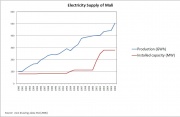Difference between revisions of "Mali Energy Situation"
***** (***** | *****) m (Wiki Gardener moved page Mali Country Situation to Mali Energy Situation without leaving a redirect) |
***** (***** | *****) m |
||
| Line 1: | Line 1: | ||
| − | {| | + | {| align="right" style="width: 400px; font-size: 14px;" border="0" cellspacing="1" cellpadding="5" |
|- | |- | ||
| − | + | ! style="width: 602px; text-align: center; background-color: rgb(79, 129, 189);" colspan="4" scope="col" | <font color="#ffffff"><span style="line-height: 20px;">Republic of Mali</span></font> | |
|- | |- | ||
| − | | [[File:Mali Flag.gif | + | | style="width: 250px; text-align: center; background-color: rgb(219, 229, 241);" rowspan="1" colspan="3" | [[File:Mali Flag.gif|center|180px|Mali Flag|alt=Flag of _____.png]] |
| − | | [[File:Mali Situation.gif|center| | + | | style="width: 250px; text-align: center; background-color: rgb(219, 229, 241);" | [[File:Mali Situation.gif|center|180px|Mali Location|alt=Location _______.png]] |
|- | |- | ||
| − | | | + | | style="width: 250px; background-color: rgb(219, 229, 241);" colspan="3" | '''Capital''' |
| − | Capital | + | | style="width: 250px; background-color: rgb(219, 229, 241);" | Bamako (12° 39′ 0″ N, 8° 0′ 0″ W) |
| − | |||
| − | | | ||
| − | Bamako ( | ||
| − | |||
|- | |- | ||
| − | | | + | | style="width: 250px; background-color: rgb(219, 229, 241);" colspan="3" | '''Official Languages(s)''' |
| − | Official | + | | style="width: 250px; background-color: rgb(219, 229, 241);" | |
| − | |||
| − | | | ||
French | French | ||
|- | |- | ||
| − | | | + | | style="width: 250px; background-color: rgb(219, 229, 241);" colspan="3" | '''Government''' |
| − | Government | + | | style="width: 250px; background-color: rgb(219, 229, 241);" | Semi-Presidential Republic |
| − | + | |- | |
| − | | | + | | style="width: 250px; background-color: rgb(219, 229, 241);" colspan="3" | '''President''' |
| − | Semi-Presidential Republic | + | | style="width: 250px; background-color: rgb(219, 229, 241);" | Amadou Toumani Touré |
| − | + | |- | |
| + | | style="width: 250px; background-color: rgb(219, 229, 241);" colspan="3" | '''Prime Minister''' | ||
| + | | style="width: 250px; background-color: rgb(219, 229, 241);" | Modibo Sidibé | ||
| + | |- | ||
| + | | style="width: 250px; background-color: rgb(219, 229, 241);" colspan="3" | '''Total Area ''''''<span style="line-height: 21px;">( </span>km²<span style="line-height: 21px;">)</span>''' | ||
| + | | style="width: 250px; background-color: rgb(219, 229, 241);" | 1,240,192 | ||
| + | |- | ||
| + | | style="width: 250px; background-color: rgb(219, 229, 241);" colspan="3" | '''Population''' | ||
| + | | style="width: 250px; background-color: rgb(219, 229, 241);" | 14,517,176 (2009 census) | ||
| + | |- | ||
| + | | style="width: 250px; background-color: rgb(219, 229, 241);" colspan="3" | '''Rural Population''' | ||
| + | | style="width: 250px; background-color: rgb(219, 229, 241);" | <br/> | ||
|- | |- | ||
| − | | | + | | style="width: 250px; background-color: rgb(219, 229, 241);" colspan="3" | '''GDP (Nominal)''' |
| − | + | | style="width: 250px; background-color: rgb(219, 229, 241);" | $8.965 billion (2009 estimate) | |
| − | |||
| − | | | ||
| − | |||
| − | |||
|- | |- | ||
| − | | | + | | style="width: 250px; background-color: rgb(219, 229, 241);" colspan="3" | '''GDP Per Capita''' |
| − | + | | style="width: 250px; background-color: rgb(219, 229, 241);" | $656 | |
| − | |||
| − | | | ||
| − | |||
| − | |||
|- | |- | ||
| − | | | + | | style="width: 250px; background-color: rgb(219, 229, 241);" colspan="3" | '''Currency''' |
| − | + | | style="width: 250px; background-color: rgb(219, 229, 241);" | West African CFA franc (XOF) | |
| − | |||
| − | | | ||
| − | |||
| − | |||
|- | |- | ||
| − | | | + | | style="width: 250px; background-color: rgb(219, 229, 241);" colspan="3" | '''Time Zone''' |
| − | + | | style="width: 250px; background-color: rgb(219, 229, 241);" | <font class="Apple-style-span" color="#454545" face="Helvetica, Arial, sans-serif" size="2"></font>GMT (UTC+0) | |
| − | |||
| − | | | ||
| − | |||
| − | |||
|- | |- | ||
| − | | | + | | style="width: 250px; background-color: rgb(219, 229, 241);" colspan="3" | '''Calling Code''' |
| − | + | | style="width: 250px; background-color: rgb(219, 229, 241);" | +223 | |
| − | |||
| − | | | ||
| − | |||
| − | |||
|- | |- | ||
| − | | | + | | style="width: 250px; background-color: rgb(219, 229, 241);" colspan="3" | '''Electricity Generation''' |
| − | + | | style="width: 250px; background-color: rgb(219, 229, 241);" | <span data-scayt_word="twh" data-scaytid="5">TWh</span>/year (year) | |
| − | |||
| − | | | ||
| − | |||
| − | |||
|- | |- | ||
| − | | | + | | style="width: 250px; background-color: rgb(219, 229, 241);" colspan="3" | '''Access to Electricity''' |
| − | + | | style="width: 250px; background-color: rgb(219, 229, 241);" | <br/> | |
| − | |||
| − | | | ||
| − | |||
| − | |||
|- | |- | ||
| − | | | + | | style="width: 250px; background-color: rgb(219, 229, 241);" colspan="3" | '''Wind energy (installed capacity)''' |
| − | + | | style="width: 250px; background-color: rgb(219, 229, 241);" | MW (year) | |
| − | |||
| − | | | ||
| − | |||
| − | |||
|- | |- | ||
| − | | | + | | style="width: 250px; background-color: rgb(219, 229, 241);" colspan="3" | '''Solar Energy (installed capacity)''' |
| − | + | | style="width: 250px; background-color: rgb(219, 229, 241);" | MW (year) | |
| − | |||
| − | | | ||
| − | |||
| − | |||
|} | |} | ||
| − | {| | + | {| align="left" class="FCK__ShowTableBorders" style="width: 350px;" border="0" cellspacing="1" cellpadding="1" |
|- | |- | ||
| __TOC__ | | __TOC__ | ||
|} | |} | ||
| + | |||
<div style="clear: both"></div> | <div style="clear: both"></div> | ||
= Overview = | = Overview = | ||
| Line 118: | Line 88: | ||
*Centrale hydroélectrique de Manantali with 200MW | *Centrale hydroélectrique de Manantali with 200MW | ||
| − | + | <br/> | |
<u>Beside these two bigger thermal power plants exist:</u> | <u>Beside these two bigger thermal power plants exist:</u> | ||
| Line 124: | Line 94: | ||
*Centrale thermique de Balingué with 23.75MW | *Centrale thermique de Balingué with 23.75MW | ||
| − | + | <br/> | |
Projects for building of solar thermal plants with a capacity of more than 100 MW are being prepared although climate proofing these installations is not yet considered. Given biomass’s central role in Mali’s energy mix, more work needs to be done on researching and developing drought resistant crops. The development of alternative fuels from biomass residues would help to off-set household energy vulnerability, particularly in rural areas. | Projects for building of solar thermal plants with a capacity of more than 100 MW are being prepared although climate proofing these installations is not yet considered. Given biomass’s central role in Mali’s energy mix, more work needs to be done on researching and developing drought resistant crops. The development of alternative fuels from biomass residues would help to off-set household energy vulnerability, particularly in rural areas. | ||
| Line 156: | Line 126: | ||
<u>HV grid:</u> | <u>HV grid:</u> | ||
| − | -Number of cuts: 2006 = 56; 2007 =49 | + | -Number of cuts: 2006 = 56; 2007 =49 |
-Duration of cuts: 2006 = 35 hours; 2007 = 19 hours | -Duration of cuts: 2006 = 35 hours; 2007 = 19 hours | ||
| Line 164: | Line 134: | ||
<br/> | <br/> | ||
| − | <u>MV grid: </u> | + | <u>MV grid:</u> |
- Number of cuts 2006 = 1251; 2007 = 1134 | - Number of cuts 2006 = 1251; 2007 = 1134 | ||
| − | + | <br/> | |
=== [[Mali: best practice case studies#Multifunctional Platforms in Mali|Multifunctional Platforms: best practice case study]]<br/> === | === [[Mali: best practice case studies#Multifunctional Platforms in Mali|Multifunctional Platforms: best practice case study]]<br/> === | ||
| Line 174: | Line 144: | ||
As part of a decade-long initiative of the '''United Nations Development Programme (UNDP)''' and United Nations Industrial Development Organization (UNIDO), the [[Multifunctional Platforms (MFP)|multi-functional platform]] project provides decentralized energy to rural villages in response to requests from local women’s associations in Mali.<br/>The small size and dispersed locations of villages in Mali make off-grid decentralized mechanical and electric energy supply the only viable option. The multifunctional platform is a 10-horsepower diesel engine that was purposefully designed to take into account multiple end uses for energy in rural economies. | As part of a decade-long initiative of the '''United Nations Development Programme (UNDP)''' and United Nations Industrial Development Organization (UNIDO), the [[Multifunctional Platforms (MFP)|multi-functional platform]] project provides decentralized energy to rural villages in response to requests from local women’s associations in Mali.<br/>The small size and dispersed locations of villages in Mali make off-grid decentralized mechanical and electric energy supply the only viable option. The multifunctional platform is a 10-horsepower diesel engine that was purposefully designed to take into account multiple end uses for energy in rural economies. | ||
| − | < | + | <br/><u>The '''project objectives''' were to:</u> |
*Provide de-centralized and sustainable energy supply to Malian villages | *Provide de-centralized and sustainable energy supply to Malian villages | ||
*Free women from arduous, repetitive, and time consuming tasks for better quality of life and ability to pursue income-generating activities and education | *Free women from arduous, repetitive, and time consuming tasks for better quality of life and ability to pursue income-generating activities and education | ||
| Line 183: | Line 153: | ||
-> For more information on the project, click [[Mali: best practice case studies#Multifunctional Platforms in Mali|here]]. | -> For more information on the project, click [[Mali: best practice case studies#Multifunctional Platforms in Mali|here]]. | ||
| − | + | <br/> | |
= Institutional Set-up and Actors in the Energy Sector = | = Institutional Set-up and Actors in the Energy Sector = | ||
| Line 191: | Line 161: | ||
=== [http://www.mmee.gov.ml/ Ministère des mines, de l’énergie et de l’eau] === | === [http://www.mmee.gov.ml/ Ministère des mines, de l’énergie et de l’eau] === | ||
| − | <br/>The Ministry for Mines, Energy and Water (MMEE) is one of the biggest and most important ministries in Mali. The MMEE is responsible for policy formulation, promotion, coordination, monitoring and evaluation. | + | <br/>The Ministry for Mines, Energy and Water (MMEE) is one of the biggest and most important ministries in Mali. The MMEE is responsible for policy formulation, promotion, coordination, monitoring and evaluation. |
<u>It is structured into three national directorates:</u> | <u>It is structured into three national directorates:</u> | ||
| Line 202: | Line 172: | ||
=== [http://www.amadermali.org/ Agence Malienne pour le Développement de l'Energie Domestique et l 'Electrification Rurale (AMADER)] === | === [http://www.amadermali.org/ Agence Malienne pour le Développement de l'Energie Domestique et l 'Electrification Rurale (AMADER)] === | ||
| − | <br/>AMADER is the Malian Agency for rural electrification and household energy. Therefore AMADER is one of the most immportant partner organisations for EnDev. | + | <br/>AMADER is the Malian Agency for rural electrification and household energy. Therefore AMADER is one of the most immportant partner organisations for EnDev. |
<u>The main task are described as follows:</u> | <u>The main task are described as follows:</u> | ||
| Line 217: | Line 187: | ||
=== [http://www.creemali.net/ Commission de Régulation de l'Electricité et de l'Eau (CREE)] === | === [http://www.creemali.net/ Commission de Régulation de l'Electricité et de l'Eau (CREE)] === | ||
| − | The CREE is the regulation authority of the water and electricity sector. | + | The CREE is the regulation authority of the water and electricity sector. |
<u>The main responsibilities are:</u> | <u>The main responsibilities are:</u> | ||
| Line 236: | Line 206: | ||
<br/> | <br/> | ||
| + | <br/> | ||
==== Société Energie du Mali (EDM-SA) ==== | ==== Société Energie du Mali (EDM-SA) ==== | ||
| Line 243: | Line 214: | ||
<br/> | <br/> | ||
| + | <br/> | ||
==== Micro-Finance Institutions ==== | ==== Micro-Finance Institutions ==== | ||
| Line 260: | Line 232: | ||
== Poverty Reduction Strategy == | == Poverty Reduction Strategy == | ||
| − | The Poverty Reduction Strategy Paper (PRSP) was adopted by the previous Government in May 2002 and then reconfirmed by the new Government (GoM) in October 2002. | + | The Poverty Reduction Strategy Paper (PRSP) was adopted by the previous Government in May 2002 and then reconfirmed by the new Government (GoM) in October 2002. |
<u>The paper names three main as well as one pre-requisite pillar as follows:</u> | <u>The paper names three main as well as one pre-requisite pillar as follows:</u> | ||
| Line 274: | Line 246: | ||
Land rights issues are linked to the national decentralised process that has been ongoing for several years. Eight laws cover the creation of municipalities one of which is the development of local government regulations and codes. In principle, rural populations will be able to (and will have to) manage their assets and ensure open land access. | Land rights issues are linked to the national decentralised process that has been ongoing for several years. Eight laws cover the creation of municipalities one of which is the development of local government regulations and codes. In principle, rural populations will be able to (and will have to) manage their assets and ensure open land access. | ||
| − | + | <br/> | |
== Energy Policy == | == Energy Policy == | ||
| Line 285: | Line 257: | ||
*pursuing petroleum research. The goal is improved sector efficiency, a withdrawal of the public sector from operations, and to extend service coverage. | *pursuing petroleum research. The goal is improved sector efficiency, a withdrawal of the public sector from operations, and to extend service coverage. | ||
| − | + | <br/> | |
<u>The three objectives of the National Energy Policy regarding renewable energy are:</u> | <u>The three objectives of the National Energy Policy regarding renewable energy are:</u> | ||
| Line 292: | Line 264: | ||
*Ensure a sustainable setting for RE-technologies | *Ensure a sustainable setting for RE-technologies | ||
| − | + | <br/> | |
The GoM has restructured the sector by adopting a new Electricity Law and its implementation texts, which ends EDM’s monopoly and has opened the sector to competition, under a regime of transparent regulation by an independent agency. Reform processes and institutions need to be strengthened to foster a lasting competitive business environment attractive to private investors and operators. The imperative to provide energy services to the poor calls for a spectrum of energy services, innovative service delivery mechanisms, with participation by communities, NGOs and the private sector. | The GoM has restructured the sector by adopting a new Electricity Law and its implementation texts, which ends EDM’s monopoly and has opened the sector to competition, under a regime of transparent regulation by an independent agency. Reform processes and institutions need to be strengthened to foster a lasting competitive business environment attractive to private investors and operators. The imperative to provide energy services to the poor calls for a spectrum of energy services, innovative service delivery mechanisms, with participation by communities, NGOs and the private sector. | ||
| Line 322: | Line 294: | ||
*The lack of local production/assembly capacity | *The lack of local production/assembly capacity | ||
| − | + | <br/> | |
= Existing Projects<br/> = | = Existing Projects<br/> = | ||
| Line 328: | Line 300: | ||
*[[Mali: best practice case studies#Multifunctional Platforms in Mali|Multifunctional platforms in Mali: best practice case study]] | *[[Mali: best practice case studies#Multifunctional Platforms in Mali|Multifunctional platforms in Mali: best practice case study]] | ||
| − | + | <br/> | |
= Further Information = | = Further Information = | ||
* | * | ||
| + | |||
[https://energypedia.info/EnDev-Mali EnDev-Mali] | [https://energypedia.info/EnDev-Mali EnDev-Mali] | ||
| − | + | <br/> | |
= References<br/> = | = References<br/> = | ||
| Line 341: | Line 314: | ||
<references /> | <references /> | ||
| + | [[Category:Country_Energy_Situation]] | ||
[[Category:Mali]] | [[Category:Mali]] | ||
| − | |||
Revision as of 09:12, 9 December 2013
| Republic of Mali | |||
|---|---|---|---|
| Capital | Bamako (12° 39′ 0″ N, 8° 0′ 0″ W) | ||
| Official Languages(s) |
French | ||
| Government | Semi-Presidential Republic | ||
| President | Amadou Toumani Touré | ||
| Prime Minister | Modibo Sidibé | ||
| 'Total Area '( km²) | 1,240,192 | ||
| Population | 14,517,176 (2009 census) | ||
| Rural Population | |||
| GDP (Nominal) | $8.965 billion (2009 estimate) | ||
| GDP Per Capita | $656 | ||
| Currency | West African CFA franc (XOF) | ||
| Time Zone | GMT (UTC+0) | ||
| Calling Code | +223 | ||
| Electricity Generation | TWh/year (year) | ||
| Access to Electricity | |||
| Wind energy (installed capacity) | MW (year) | ||
| Solar Energy (installed capacity) | MW (year) | ||
Overview
Mali is a net importer of petroleum products. Its energy situation is characterised by the predominance of biomass (87 %) in meeting the needs of households for cooking, and by a very low level of electrification (16 %).
Access to Electricity (% of households) 2001: 9%(32% urb.); 2007: 17%.(51% urb.)
Extreme poverty denies access to modern energy services to much of the population.
The energy supply in Mali is very low. The newest official energy balance available shows that only 2,929 ktoe were consumed in 2000. Thereof 85 % are used as traditional sources (e.g. firewood), 14% are oil and petrol products and the electricity consumption only accounts 1% of the total energy consumption.
Mali has an relatively high potential for hydropower. It is estimated in 1,000 MW with an average annual production of 5,000 GWh. But just one quarter of the potential is used.
Despite changing temperatures and migrating rainfall patterns, Mali appears well placed to increase the resilience of its hydro and renewable energy systems. Plans for optimised operation of hydro plants under projected flow regimes are in place and siting maps that detail projected changes in windspeed, floodplains, and areas impacted by sea level rise exist.
There are three big hydropower stations:
- Centrale hydroélectrique de Sélingué with an installed capacity of 46.24MW (Kaplan-turbine)
- Centrale hydroélectrique de Sotuba (Kaplan-turbine)
- Centrale hydroélectrique de Félou with 680kW (Francis-turbine)
- Centrale hydroélectrique de Manantali with 200MW
Beside these two bigger thermal power plants exist:
- Centrale thermique de Dar Salam with 36.52MW
- Centrale thermique de Balingué with 23.75MW
Projects for building of solar thermal plants with a capacity of more than 100 MW are being prepared although climate proofing these installations is not yet considered. Given biomass’s central role in Mali’s energy mix, more work needs to be done on researching and developing drought resistant crops. The development of alternative fuels from biomass residues would help to off-set household energy vulnerability, particularly in rural areas.
The off-grid electricity supply is mainly garanteed by small diesel generators (with a capacity between 80kW to 1,220 kW).
Energy Demand and Supply in the Household Sector
Households (mostly rural poor) consume 86 % of Mali’s energy, (road) transport 10 %, industry (mainly mining) 3 % and agriculture 1 % (2003 figures). 80 % of total energy consumption is based on firewood and charcoal (increasing by 3 % and 10 % annually, respectively). Oil products account for 16 % (annual increase 10 %), placing a heavy financial burden on the national economy which is wholly dependent on oil imports.
Electricity accounts for only 3 % of Mali’s energy consumption and less than 20 % of the total population are connected to the national grid. Mali's power grid covers only a few urban areas, leaving more than 97 % of the rural population without access to electricity. However, only fractions of Mali’s huge renewable power generating potential (hydro, solar) are exploited. In recent years, the necessity of tapping these resources for rural electrification was clearly identified.
The total electricity generation in 2006 was about 505 GWh and the installed capacity was 280 MW. Since 1980 the consumption increased constantly, while the installed capacity of all plants remained at the same level in the 1980s and 1990s. Recently at the beginning of the new century the pattern changed and new production facilities were build (see graph).
EDM, the state energy utility, is expected to reach only 60 urban locations through the national grid.
Rural Electrification
More than 97% of the rural population live without access to electricity. A very small number of households uses automotive batteries for lighting, TV and radio. Their supply is hardly possible and to recharge them long journeys (up to 120 km) to the capital of Bamako or regional and district centres are needed. In addition, the quality of charge is often deplorable.
Length of Domestic Transmission and Distribution Lines 4436 km, Transnational Lines 600 km.
Number and Length of Power Cuts
HV grid:
-Number of cuts: 2006 = 56; 2007 =49
-Duration of cuts: 2006 = 35 hours; 2007 = 19 hours
-Number of cuts scheduled for works 2006 = 15; 2007 = 19
MV grid:
- Number of cuts 2006 = 1251; 2007 = 1134
Multifunctional Platforms: best practice case study
As part of a decade-long initiative of the United Nations Development Programme (UNDP) and United Nations Industrial Development Organization (UNIDO), the multi-functional platform project provides decentralized energy to rural villages in response to requests from local women’s associations in Mali.
The small size and dispersed locations of villages in Mali make off-grid decentralized mechanical and electric energy supply the only viable option. The multifunctional platform is a 10-horsepower diesel engine that was purposefully designed to take into account multiple end uses for energy in rural economies.
The project objectives were to:
- Provide de-centralized and sustainable energy supply to Malian villages
- Free women from arduous, repetitive, and time consuming tasks for better quality of life and ability to pursue income-generating activities and education
- Aid women’s associations in obtaining credit
- Train women in management and maintenance and provide them with numeracy, literacy, and entrepreneurial skills
- Spur small-scale industrial development[1]
-> For more information on the project, click here.
Institutional Set-up and Actors in the Energy Sector
Public Institutions and Actors
Ministère des mines, de l’énergie et de l’eau
The Ministry for Mines, Energy and Water (MMEE) is one of the biggest and most important ministries in Mali. The MMEE is responsible for policy formulation, promotion, coordination, monitoring and evaluation.
It is structured into three national directorates:
- La Direction Nationale de la Géologie et des Mines
- Direction Nationale de l’Energie (DNE)
- La Direction Nationale de l’Hydraulique
Agence Malienne pour le Développement de l'Energie Domestique et l 'Electrification Rurale (AMADER)
AMADER is the Malian Agency for rural electrification and household energy. Therefore AMADER is one of the most immportant partner organisations for EnDev.
The main task are described as follows:
- Acceleration of the use of modern energy in rural and periurban areas.
- Promotion of community-based forest management
- Support the reform of the energy sector and related institutions
Centre National d’Energie Solaire et des Energies Renouvelables (CNESOLER)
Commission de Régulation de l'Electricité et de l'Eau (CREE)
The CREE is the regulation authority of the water and electricity sector.
The main responsibilities are:
- Assistance in the development of sector strategies
- Control of tenders and grant of concessions
- Approbation and control of tariffs
Non Governmental Service Providers for Rural Areas in the Field of Energy
Commercial Service Providers
ESKOM-ENERGIE-MANATALI (EEM)
The EEM is a local branch of the South African Eskom SA. Is is responsible for the operation of the Manantali hydroelectric power plant at the Malian-Senegalese-Mauritanian border. The installed capacity is 200 MW.
Société Energie du Mali (EDM-SA)
The former state-owned EDM was privatized in 2000 and is now owned by the SAUR-IPS group (60 %), while 40 % of the shares remain with the state. EDM is the only concessionaire for the public electricity supply. Beside the grid-system there are 21 isolated production centres with an installed capacity of 38.4 MW. In 2006 these systems produced 101 million kWh.
Micro-Finance Institutions
- Aga Khan Agency for Microfinance (AKAM)
- Union des CAECE du Mali
- Banque Malienne de Solidarité (BMS)
-> GTZ-Publication: Les Associations des Institutions de Microfinance
Policy Framework
Poverty Reduction Strategy
The Poverty Reduction Strategy Paper (PRSP) was adopted by the previous Government in May 2002 and then reconfirmed by the new Government (GoM) in October 2002.
The paper names three main as well as one pre-requisite pillar as follows:
- Pre-Requisite Pillar: Accelerated and Re-Distributive Growth
- Pillar 1: Promote institutional development while improving governance and participation.
- Pillar 2: Develop human resources and improve access to quality basic services.
- Pillar 3: Develop basic infrastructure and productive sectors.
Land Ownership and Participation
Land rights issues are linked to the national decentralised process that has been ongoing for several years. Eight laws cover the creation of municipalities one of which is the development of local government regulations and codes. In principle, rural populations will be able to (and will have to) manage their assets and ensure open land access.
Energy Policy
The general energy strategy of Mali focuses on the development of local resources such as hydropower and solar energy in order to reduce petroleum imports. In 1999, the Government of Mali (GoM) issued a policy letter with the following goals:
- sector liberalisation, allowing initiatives from communities and the private sector;
- institutional reforms to orient the State’s responsibility to activities of strategic and regulatory nature;
- valorisation of national energy resources (renewable energy, hydroelectricity);
- protection of forestry resources through sustainable exploitation benefiting rural populations;
- pursuing petroleum research. The goal is improved sector efficiency, a withdrawal of the public sector from operations, and to extend service coverage.
The three objectives of the National Energy Policy regarding renewable energy are:
- Promotion of RE. The percentage of electricity generated by RE shall reach 6 % in 2010 and 10 % in 2015 (it was less than 1 % in 2004)
- Search for financing mechanisms adapted to RE-technologies.
- Ensure a sustainable setting for RE-technologies
The GoM has restructured the sector by adopting a new Electricity Law and its implementation texts, which ends EDM’s monopoly and has opened the sector to competition, under a regime of transparent regulation by an independent agency. Reform processes and institutions need to be strengthened to foster a lasting competitive business environment attractive to private investors and operators. The imperative to provide energy services to the poor calls for a spectrum of energy services, innovative service delivery mechanisms, with participation by communities, NGOs and the private sector.
Key Problems Hampering Access to Modern Energy Services in Rural Areas
Obstacles for Grid Based Rural Electrification
The existing national electrification policies are not yet ready to close the existing energy gap: EDM, the state energy utility, is expected to reach only 60 urban locations through the national grid. Mali's Agency for Domestic Energy and Rural Electrification (AMADER), whose rural electrification strategy focuses on the creation of a private sector in which public/private partnerships on a local level should take a lead role in the rural electrification process, seems to be completely surpassed by the task to provide the off-grid majority of over 700 rural communes (11.000 villages) with access to electricity. Both central state institutions have neither the capacity nor the resources to achieve their national goal. Most remote rural areas will not be targeted and even if there are no local capacities available who could implement the ambitious programmes. They also insufficiently interlink electricity provision with decentralisation politics and; fail to involve the local municipalities in planning and running the energy facilities which is crucially important to ensure their long-term sustainability. Without tapping this potential of participatory communal development, the national goal of reaching 12 % rural electrification rate by 2012 and 55 % by 2015 will be out of reach.
The key problems for the grid-based electrification are:
- The incoherence and imprecision of the EDM´s electricity concession´s contract
- The non-execution of investment programmes by EDM
- The low efficiency and high losses in EDM´s electric system
- The high tariffs for rural consumers
Obstacles for Off Grid Energy Technologies and Services
There are some key problems for the off-grid electrification as well:
- The absence of a coherence strategy for rural electrification
- The absence of appropriate finance mechanisms and institutions
- The lack of qualified technicians for customer service
- The lack of local production/assembly capacity
Existing Projects
Further Information
References
- ↑ GTZ (2007): Eastern Africa Resource Base: GTZ Online Regional Energy Resource Base: Regional and Country Specific Energy Resource Database: VII - Best Practice Case Studies.




















